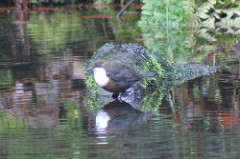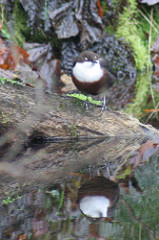
It was my partner Jen's birthday today, so we took the day off work and went for a walk to a local beauty spot. On our way to the pub, that is.
During our walk, I was delighted to spot one of my favourite birds, the dipper [Cinclus cinclus], which was feeding at the edge of an old mill-pond. The light was poor and the bird was a long way off, but I did manage to take a few photos, including the two heavily cropped ones you see here.
The dipper is a very unusual creature. It is a song-bird the size of a small thrush (although not, as cladists used to classify them, an actual thrush), but it catches its food (mainly invertebrates) under water, using its wings to counteract its natural buoyancy. That's a song-bird that hunts under water. Very odd.

The name dipper derives from the bird's characteristic bobbing motion, which resembles a curtsey. An older name for the bird is the water ouzel: ouzel being an old name for the blackbird, a true thrush, which the dipper superficially resembles. It was under this old name that Charles Darwin described the dipper in chapter 6 of 'On the Origin of Species'.
[T]he acutest observer by examining the dead body of the water-ouzel would never have suspected its sub-aquatic habits; yet this anomalous member of the strictly terrestrial thrush family wholly subsists by diving, grasping the stones with its feet and using its wings under water.
He who believes that each being has been created as we now see it, must occasionally have felt surprise when he has met with an animal having habits and structure not at all in agreement.
Darwin's point was that, although the dipper has evolved a number of special features to assist with its unusual aquatic lifestyle—dense feathers for insulation, an enlarged oil gland for waterproofing, and a specialised nictitating membrane to protect the eye when under water—it lacks other more obvious features, such as webbed feet, which are present in many other aquatic birds.
The design constraints imposed on the process of evolution by means of Natural Selection—which can only work on what is already available, rather than start from scratch—mean that many species contain apparent design flaws. We would not expect this to happen if, instead of evolving, species were designed by some omnipotent, benevolent creator.
Mind you, the Lord, like the dipper, is known to move in mysterious ways.